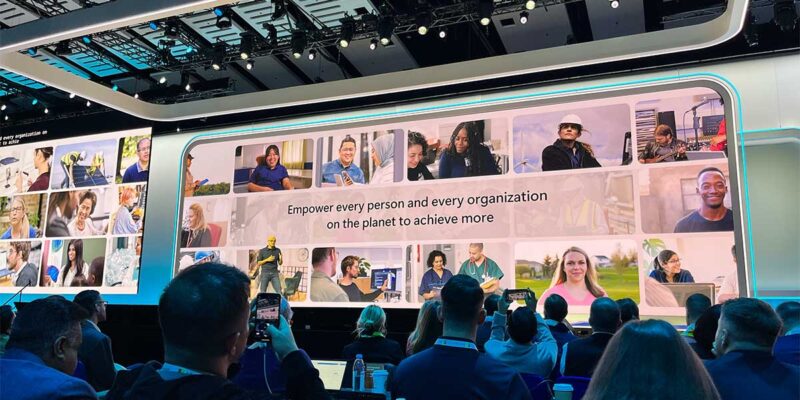Understanding Microsoft’s Device Ecosystem Platform (MDEP): Benefits, Challenges and Industry Impact
 As hybrid work continues to reshape the way businesses operate, the tools and platforms that enable seamless collaboration are becoming more important than ever. One of Microsoft’s boldest moves in this space is the introduction of the Microsoft Device Ecosystem Platform (MDEP), a standardized, Android-based platform specifically designed to address the challenges of managing collaboration devices. But what exactly is MDEP, and why have some manufacturers embraced it while others hesitate? This blog explores the benefits, challenges, and impact of MDEP on the collaboration industry.
As hybrid work continues to reshape the way businesses operate, the tools and platforms that enable seamless collaboration are becoming more important than ever. One of Microsoft’s boldest moves in this space is the introduction of the Microsoft Device Ecosystem Platform (MDEP), a standardized, Android-based platform specifically designed to address the challenges of managing collaboration devices. But what exactly is MDEP, and why have some manufacturers embraced it while others hesitate? This blog explores the benefits, challenges, and impact of MDEP on the collaboration industry.
Why Microsoft Developed MDEP
Before the introduction of MDEP, Microsoft faced significant challenges in managing the collaboration devices ecosystem, especially with Android-based devices like Microsoft Teams Rooms on Android (MTRoA). The problem was fragmentation: every original equipment manufacturer (OEM) built slightly different versions of Android, leading to inconsistencies in security, performance, and management. This divergence not only created headaches for IT teams but also made it difficult for Microsoft to maintain feature parity between Android- and Windows-based Microsoft Teams Rooms (MTR) devices.
To solve this, Microsoft envisioned a unified platform that could standardize and streamline the experience. The result was MDEP, a custom version of Android that meets Microsoft’s requirements for security, management, and performance. By building MDEP, Microsoft sought to create a more controlled environment where updates, security patches, and new features could be rolled out seamlessly across all devices. The MDEP Android firmware is available now, and the ability to manage it is just coming online after a long wait.
It is important to note that while MDEP will help Microsoft roll out more consistent security patches to Android devices, it isn’t a panacea. Manufacturers will still need to ensure that the firmware they release is secure and reliable. MDEP is also not a solution that just anyone can use. Manufacturers will need to partner with Microsoft to enable the platform.
The Benefits of MDEP
MDEP brings several clear advantages to the table, making it a game-changer in the world of collaboration technology:
- Security Enhancements: One of the key benefits of MDEP is improved security. Microsoft takes direct responsibility for managing security patches and updates, reducing the burden on OEMs to keep devices secure. This ensures that all MDEP-based devices receive timely patches and updates, keeping them protected from emerging threats.
- Consistency in Experience: Whether a device is used in a large conference room or a smaller huddle space, MDEP ensures a consistent user experience across all devices. This uniformity eliminates the variability that often plagues multi-OEM environments and allows businesses to offer their employees a seamless collaboration experience.
- Simplified IT Management: For IT teams, MDEP simplifies the process of managing and maintaining devices. With MDEP, updates and security patches can be centralized, reducing the complexity of managing multiple devices from different manufacturers.
- Future-Proofing Innovation: With a standardized platform in place, Microsoft can more easily introduce new features and innovations across the entire ecosystem. This ensures that businesses using MDEP-based devices are always on the cutting edge of collaboration technology, without being bogged down by the fragmentation of different Android versions.
Challenges and Considerations for Manufacturers
While MDEP offers many benefits, not all manufacturers are eager to jump on board. There are several reasons why some companies may be reluctant to adopt the platform:
- OEM Dependency on Custom Android Versions: Some manufacturers, such as Poly, Neat, and Logitech, have spent years developing their own customized Android-based platforms. These platforms allow them to differentiate their products with unique features and user experiences. Switching to MDEP would mean giving up some of that control and reengineering their devices to fit Microsoft’s standards.
- Loss of Differentiation: By adopting MDEP, manufacturers may lose some of the unique features that set their devices apart from competitors. For companies that have built their reputations on offering distinct Android-based solutions, this can be a major drawback.
- Costs and Resources: For manufacturers that have already invested heavily in their own Android solutions, switching to MDEP could be costly. They would need to allocate resources to rework their existing products and shift their development efforts to align with MDEP. For some, the potential benefits may not outweigh the costs.
- Concerns About Microsoft Control: Some OEMs are wary of giving Microsoft more control over their device ecosystems. By adopting MDEP, manufacturers would be reliant on Microsoft for updates, security patches, and feature rollouts, which could limit their ability to innovate independently. It is also not yet clear if other collaboration platforms, such as Zoom or Google Meet, will agree to work on the MDEP platform—or if they even need to.
Why Some Manufacturers Embrace MDEP
On the other hand, several manufacturers have embraced MDEP for the advantages it provides, particularly those who haven’t invested heavily in their own Android platforms. Companies like Barco, Jabra, and Yealink have seen the value in leveraging Microsoft’s expertise to enhance their products.
Barco, for example, has fully adopted MDEP for its ClickShare product ecosystem. This deeper integration with Microsoft’s collaboration framework reflects a long-term strategy for standardization and scalability. Smaller OEMs, such as Jabra and Yealink, benefit from reduced development burdens by adopting Microsoft’s Android code, allowing them to focus on hardware and user experience.
The Future of MDEP in the Collaboration Industry
As MDEP continues to evolve, more OEMs are likely to adopt the platform to streamline their development processes and integrate more closely with Microsoft’s enterprise ecosystem. If widely adopted, MDEP could drive standardization in the collaboration space, making hybrid work environments easier to manage for IT teams. However, standardization could also commoditize the hardware market, removing some unique differentiators.
For manufacturers, the decision to adopt MDEP will hinge on balancing the benefits of standardization and security with the desire to maintain control over proprietary software and innovations. Some OEMs will resist the switch, while others will see MDEP as a way to future-proof their offerings and reduce development costs.
Takeaways for Users
Microsoft’s Device Ecosystem Platform represents a significant shift in how collaboration devices are managed and secured. By offering a standardized, secure platform, MDEP addresses many of the challenges that have plagued the collaboration industry, including Android fragmentation and security vulnerabilities. While some manufacturers may hesitate to adopt MDEP due to concerns over control and customization, others view it as a way to reduce costs and enhance security.
Ultimately, MDEP’s success will depend on its ability to strike the right balance between innovation and standardization, creating a future where collaboration technology is more cohesive, reliable, and secure. It will also require trust and cooperation from both Microsoft and the manufacturers, who will still bear ultimate responsibility. As the platform evolves, it has the potential to reshape the collaboration industry and set new standards for how businesses approach hybrid work environments. Manufacturers making a full commitment to MDEP are a clear indicator of the platform’s potential to drive the next generation of collaboration solutions.




